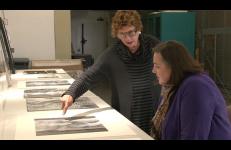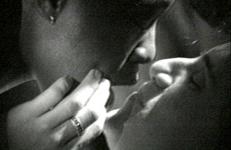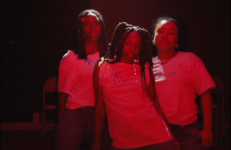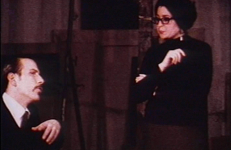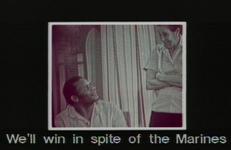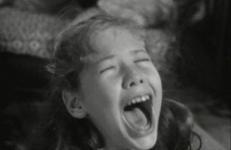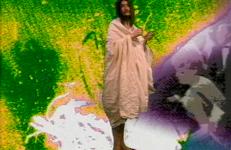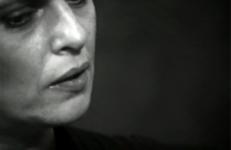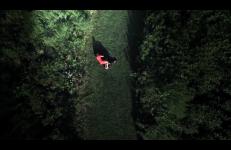Feminism
In a piece commissioned by Remy Martin, Birnbaum adopts the language of commercial advertising, using the body, gestures, and glances of a heavily made-up woman to create a scene of glamour and romance—while slipping in a disparaging narrative that touches on the actual use and abuse of Remy Martin's product. Birnbaum sets up a typical commercial, then allows the fictive narrative to intrude, upsetting the advertised fantasy with a dose of unpleasant reality.
Canadian-born artist Miriam Schapiro (b.1923) was one of the great forces behind the feminist art movement in Los Angeles. Originally painting in an Abstract Expressionist manner, she developed a new, more personal style of assemblage she called “femmage” as she became more politically involved. She was also one of the first scholars to create a curriculum on Feminist Art at CalArts. Through the use of large scale media and symbols emblematic of the female, she has battled to pay homage to women and their undervalued domestic traditions.
From A to Z in this mock cooking-show demonstration Rosler 'shows and tells' the ingredients of the housewife's day. She offers an inventory of tools that names and mimics the ordinary with movements more samurai than suburban. Rosler's slashing gesture as she forms a letter of the alphabet in the air with a knife and fork is a rebel gesture, punching through the 'system of harnessed subjectivity' from the inside out.
"I was concerned with something like the notion of 'language speaking the subject', and with the transformation of the woman herself into a sign in a system of signs that represent a system of food production, a system of harnessed subjectivity."
— Martha Rosler
All forms of human sport become sites for sexual play and celebratory eroticism.
“The tape’s images are quick, suggestive, and sexy: fingers moving into bowling balls, shoe-smelling and toe-sucking, a dog wearing chain jewelry, fish being wrapped at the market, young naked couples having sex.... Edited like a music video, the image track is a constant flow of fetishes that lure us into the promiscuous pace of girls who keep lists of their sexual encounters.”
An erotic lesbian video involving swimming upstream, female power, and fish love. Made as a collaboration under the name E.T. (Ela Troyano) Baby (Jane Castle) Maniac (Cheang).
She Mad is an episodic project that uses fragments from the sitcom format to explore the sign of blackness in the public imagination. It is a way to think about surveillance, visibility, and the gulf between lived experience and representation. The show follows Martine, a graphic designer who wishes she were an important artist. She is an overachieving stoner who lives in Hollyweird.
"A cinematic doppelganger without precedent, Elisabeth Subrin’s Shulie uncannily and systemically bends time and cinematic code alike, projecting the viewer 30 years into the past to rediscover a woman out of time and a time out of joint — and in Subrin’s words, "to investigate the mythos and residue of the late '60s."
In 1985, Hollis Sigler, a leading feminist artist in Chicago, was diagnosed with breast cancer, a disease that had also stricken her mother and great-grandmother. This interview with Hollis Sigler focuses on the period of her life beginning with the work entitled Breast Cancer Journals, a series of paintings, drawings, and collages expressing a wide range of emotional responses to the various stages of her struggle with cancer encompassing more than 100 works. Art in America called Sigler’s Breast Cancer Journals “one of contemporary art's richest and most poignant treatments of sickness and health.Taking on a kind of religious conviction, her jewel-colored symbols imbue a death-haunted situation with miraculous, celebratory life.”
Sing, O Barren Woman, part documentary part music video, satirizes and celebrates a taboo subject--voluntary childlessness. Susan Mogul gives voice to ten women who are childless by choice (or default) as they come out as non-mothers speaking and "singing" about the stereotypes of the "barren" woman. "Never mentioned in public or given a voice, we’re invisible women who made a provocative choice." These various refrains crescendo to Susan’s humorous song of sexual innuendo "Baby, I Still Can Conceive." This is the first U.S. film or video on voluntary childlessness.
Small Miracles is a suite of eight video animations in which the artist conjures up and controls forces of nature. Ignoring rational constructs of what is possible, Hechtman creates imaginary works to ground science fiction in the everyday experience. Coupling feminism and natural phenomena, the videos are located in the liminal space between fantasy and the everyday.
Employing the 'case studies' of Helen Keller, Genie the 'wild child' and Angel at My Table author Janet Frame, Goss's extraordinary video contemplates the struggle to be heard, to break free from the prison of the incommunicable self. '[A] tour of the house and grounds of language,' constructed with beguiling visual spaces and surfaces, startling edits, and insinuatingly layered sound design. —New York Video Festival (2000)
Horizontes incorporates scenes from a popular Cuban soap opera with running commentary in the form of a propagandistic advertising text. Blumenthal examines media programming as presenting, through the filter of a generalized moralism, a reconstructed history that mirrors the values of the dominant class. The media both "collects and corrects public memory."
Available in Spanish and English.
This title is also available on Lyn Blumenthal Videoworks: Volume 1.
The "dazzling, delightful, and delicious" messages of broadcast television get scrutinzed in Social Studies, Part II: The Academy. Stripped of its glitzy animation and played out against the frozen backdrop of a single spectacular image, the standard Academy Award Ceremony fare of introductions, applause, film-clips, commentary, self promotion, and professional banter shifts the banal mise-en-scene into proto-fascist theater.
Executive Producer, Suzanne Lacy; Director, Steve Hirsch; Editor, Doug Gayeton.
From the performance Freeze Frame: Room for Living Room by Suzanne Lacy, Julia London, Ngoh Spencer, and Carol Leigh, San Francisco, 1982.
In Spank an eight-second film clip has been re-edited, frame by frame, into a 7 1/2-minute video, tranforming discreet gestures into suggestive, pulsating sequences. This deconstruction of narrative Hollywood cinema exposes and intensifies the authoritative relationship between a man and a young girl.
Best known for her drawings and prints, Nancy Spero (1926-2009) worked as an oil painter on both paper and canvas and with installations. As both artist and activist, Nancy Spero's career spanned fifty years. Spero was active in many radical groups including WAR (Women Artists and Revolution) and AIR (Artists in Residence), the first women’s cooperative gallery in New York. She was renowned for her continuous engagement with contemporary political, social, and cultur
Sphinxes Without Secrets is an energetic and transgressive acount of outstanding female performance artists, and an invaluable document of feminist avant-garde work of the 70s and 80s. No Mona Lisa smiles here, as performance artists spill their guts about what outrages and delights them. Performers, curators, and critics unravel the mysteries of a new art form and ponder the world women confront today. Since its inception, performance art has provided a forum for artists who create work that challenges the dominant aesthetic and cultural status quo.
A Spy is a gender-bending and thought-provoking mixture of pure visual pleasure with disturbing undercurrents. As Reeve lip-syncs to a Doors song (“I am a spy in the house of love. I know the dream that you’re dreaming of, I know your deepest secret fear...”), we see a new manifestation of Jesus walking in a video field of pulsing rainbows, amoebic forms, and B-movie girls in black panties — suggesting the desires we try to hide from ourselves and others.
Thinking of herself as a spy assigned by the female sex, Green reinterprets baseball’s symbolism—its womblike landscape, its cycles and rituals—and constructs an iconography that pays homage to the female. In one magnificent montage, numerous phallic symbols pass by as Green sees the real purpose of the game: baseball is the only sport about returning home—and where is home...? In a mother’s belly. With humor and irony, Green creates a tape that is both a personal revelation and a heretical portrait.
Pat Steir (b.1938) is an American painter and printmaker, whose work has resisted artworld currents and factions for decades while maintaining enthusiastic critical support.
Pat Steir (b.1938) is an American painter and printmaker, whose work has resisted artworld currents and factions for decades while maintaining enthusiastic critical support. She graduated from Pratt in 1962 and in 1964 was included in the show Drawing at the Museum of Modern Art in New York and had her first solo exhibition at the Terry Dintenfass Gallery, New York. She first came to prominence in the 1970s, when her work concentrated on signs and symbols and was close to minimal and conceptual art.
Strangely Ordinary This Devotion is a visceral exploration of feral domesticity, queer desire, and fantasy in a world under the threat of climate change. Utilizing and exploding archetypes, the film offers a radical approach to collaboration and the conception of family. Dani and Sheilah collect and arrange images and moments that are at once peculiar and banal, precious and disturbing, creating resonance and contrast through experimental modes of storytelling.
Strangely Ordinary This Devotion is a visceral exploration of feral domesticity, queer desire, and fantasy in a world under the threat of climate change. Utilizing and exploding archetypes, the film offers a radical approach to collaboration and the conception of family. Dani and Sheilah collect and arrange images and moments that are at once peculiar and banal, precious and disturbing, creating resonance and contrast through experimental modes of storytelling.




